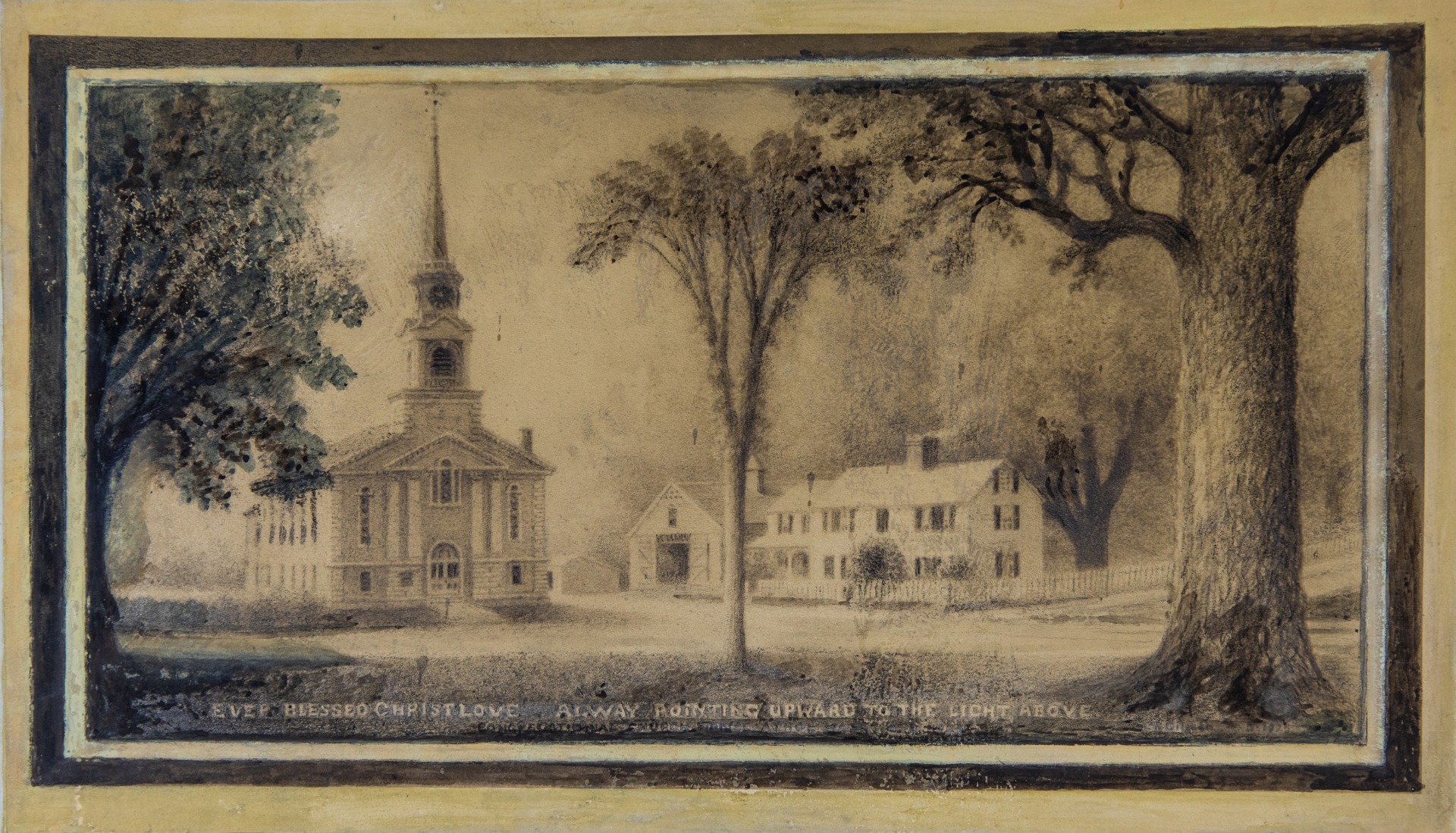The James Gilman Story, Illustrator of her poem, Christ and Christmas
Mrs. Eddy's demonstration of this book included finding an artist whose thought was not only developed according to artistic standards, but who also possessed a spiritual tendency of thought through which she could work. He must be able to catch her inspiration in his brushmarks. Gilbert Carpenter, Introductory Critique, Recollections of Mary Baker Eddy by James Gilman
Mrs. Eddy said of me that it was strange why it was that she was led into so much to do with me. She said she was sure that I was to be a great factor in Christian Science experience or history sometime. James Gilman

Before illustrating Christ and Christmas, Gilman often drew homes and churches in neighboring towns in search of his life purpose and desire to be a self-supporting artist.
Gilman drawing of the Baker Homestead in Bow
(James Gilman) first appeared to Mrs. Eddy as a lone, homeless wanderer, with a native ability for picture making...seeking even from his youth, the definition and fulfilment of soulful, but yet undefined ideals.
A vague, nameless sense of Infinite Beauty attended his thought from childhood, and as he grew toward maturity, the things that had dominated his thought before grew in urgency and pressed him to find the opportunity for their unfoldment in some appropriate, practical action James Gilman

I think I can never forget the beautiful picture impressed upon my mind by this brief incident, the center of interest of which is in the pure light figure of Mrs. Eddy sitting in her carriage (of enclosed form to suit the season) as I first saw her at the opening of the carriage door, extending her hand to me in her gentle way, and a smiling face that appeared to me then under the peculiar circumstances of the hour as an angel from heaven, who had intervened just at the right moment needed to save me from the burden of seeking for work to do in order to live from people who would not have my work anyway if they knew I was favorably interested in Christian Science and Mrs. Eddy.
Saturday, March 11, 1893. – Went to Mrs. Eddy's this evening... She told me that she had written a poem which she had entitled Christ and Christmas, and said she wanted to have some illustrations made for it, and asked me if I thought I could make them.
In reply to her question I said I should be very glad to undertake to make such illustrations if she had confidence in my ability to do it satisfactorily. She said she felt confident I could do anything in accord with my ideal aspirations as an artist. Mrs. Eddy then read me the poem which appeared to me very beautiful and grand. James Gilman



James Gilman endured many trials throughout his work for Mrs. Eddy. Early on in the process, he one day found himself evicted from his boarding house!
"During several weeks previous to the twenty-fifth of April a condition of resistance of personal material thought against me had been becoming manifest. Very much error had been uncovered to me during that time through the action of Truth as reflected to me by Mrs. Eddy. Our textbook states a fundamental truth in the sentence: "Uncover error, and it turns the lie upon you" (Science and Health, p. 92). As I appeared connected with this uncovering, persecution began to be directed against me on the basis of belief that I in some subtle unknown way was secretly a foe to the Cause of Christian Science in Concord and therefore to the Cause generally. This resulted finally in an abrupt vacation of my room at No.7 Chapel Street...At the room I had vacated a little device had been prepared to catch me technically as a law-breaker – "breaking and entering" – but the spirit of Truth guided my eye to see the innocent form of the snare before I was caught in it, and thus the evil purpose was frustrated and when I returned with legal right to obtain my belongings, I was greatly disrespected and verbally abused, but this could not hinder my coming into possession of my own and taking them away in security."
Mrs. Eddy was quick detect the thoughts of James Gilman and inquired about his situation. After hearing this story she said to him when she was writing Science and Health:
" ' I moved nine times while writing the book, and that chair was the only furniture and about all I possessed, and my writing desk was simply a piece of book cover cardboard. There was no good reason for my moving except the antagonism that was felt to the ideas and to me for voicing them. In one case the woman of the house having ordered me to go, I got all ready to go, but I wanted to write a few paragraphs that I had in thought, and went into the kitchen to do it, and the woman tried to smoke or steam me out by throwing water onto the hot stove, thus making so much steam that the woman could not stay in the room," but she kept right on writing, paying no attention to it. The woman's husband was before this an infidel, but seeing how she bore these persecutions, he became a Christian.' " James Gilman



"After she commenced to talk about the illustrations, she said she had been changing the verses around some and she thought she had made an immense improvement. This she stated with a great deal of interest, and producing the poem, she read me the verses in the order in which she had rearranged them, which placed the verses calling for the illustration of the one rising up out of the casket, second.
She said, 'I must represent Jesus raising the dead in the first illustration with a person represented in it. This now places Jesus first in the order of the illustrations.' She said, 'As it was before, people would say that she was giving Christ or Jesus a secondary place; but now he would be placed first, thus rendering him his due.' "



I was recently at lunch and the dish of beautiful, delicious, ripe strawberries was presented and at the same lunch you (Mrs. Eddy) were expressing the rare spiritual love thoughts that appear so natural to you to express, I felt more fed and satisfied without the strawberries. Your spiritual thoughts of divine Love were feeding me making material food very subordinate and not needed, and therefore not desired.
Soon after lunch I went up in the room over the library called "Benny's room" (Dr. Foster Eddy's) where Mrs. Eddy said we could go to attend, free from interruption, to the perfecting with her of some designs and drawings relating to the illustration "Seeking and Finding," which she was much interested in. At this time the question was as to the position of the hand on which the head of the woman in the picture was lightly resting. To get this more surely accurate, Mrs. Eddy consented to sit as a model with her head resting lightly against her hand as in the illustration. James Gilman



On my way home I was beset by thoughts that were unfavorable to previous conceptions of Christian Science and Mrs. Eddy. These thoughts were unwelcome to me, and unreasonable from any spiritual just point of view. I found I wished to be regarded as I was in the real being, as I was when I was completely myself, spiritually, and this helped me finally to the overcoming of these unnatural, unfavorable thoughts, although I had a hard battle until midnight.
I told Mrs. Eddy that when I became willing, if not glad, to bear any sense of material burden for the sake of Truth's increase in my thought, that that willingness gave me a sense of mastery over the claims of evil that nothing else could. Mrs. Eddy immediately replied, "That is what I mean is the way you are to master the sense of evil and thus demonstrate it's nothingness." James Gilman



Monday, June 19, 1893 - I went up to show Mrs. Eddy a single picture that I had mostly spent the four days in the week in making the illustration 'Christmas Morn' with two angels moving swiftly through the air to welcome the approaching dawn. These angels were not to be delineated in the usual conventional way as having "feathered wings," an ideal that Mrs. Eddy objected to as being unnatural and confusing.
Upon seeing my effort, Mrs. Eddy laughing kindly, asked me where the angels were. I frankly answered as if her question was intended to be regarded seriously, pointing to the figures I had drawn to represent the angels. "Oh, I thought those were tadpoles." She then said laughing compassionately, "Now, that is too bad to say, isn't it, Mr. Gilman." Mrs. Eddy said shortly before I went, thinking perhaps I would feel disheartened, that God would surely help me do my work, and "God bless you." I thought as I walked home that I was now prepared for severe testing as I had previously. The next day it was the severest I believe I ever experienced. The day was a "black Friday" to me. In my thought I was seeking to endure the mental testing for Truth's sake. I had become willing to bear it from the Christ motive.
After a costly struggle I felt better and had began to rise out of the dark valley toward the uplands. Saturday evening light dawned upon me. It showed me it was divine Love alone that illumines our way and makes our tasks light, and seeking to know for a certainty that I love God was what I ought to labor for more.
Immediately after the peculiar dark period of conflict with evil belief followed by the new dawn of Truth's light, I walked toward Bow Mills around sunset. In this walk I was still naturally in my freshly attained chastened sense, and therefore more ready to hear and see more spiritually. The sky was mostly cloudy, but a break in the clouds in the west occurred as I walked, so that the sundown rays of light streamed through, causing a sharp cupola that was on a building just in line with me and the sunset rays of light, together with some beautiful trees, to appear silhouetted against the light western sky in a very picturesque, artistic way. Immediately the spirit of Truth said to me, "There, that is what is wanted in the picture with the angels to represent 'the heavenly worth of that high morn.' "
And so it proved afterwards when I incorporated it into the illustration, for when I showed it to Mrs. Eddy, she at once expressed great joy because of the spiritual beauty of the whole picture as expressing her sense of the verse and she asked for no changes to be made. In the finished illustration, the spire of the church is made higher than the cupola on the building to suit poetic requirements, but it was the product of the ideal God gave me in nature to supply my need. (The distant dome in this picture which I added for beauty's sake and thinking of the State House Dome in Boston, appears at a later date to have been prophetic of the present Month Church dome erected A.D., 1906.) James Gilman



During the week past since then I have been making the picture of the illustration "Christian Science Healing," and in particular of Mrs. Eddy, as the type of the woman engaged in this picture as healing the sick man. When we were considering the details of the design...the question of what was the most spiritually appropriate disposition of the hands and arms was up for final decision. I reasoned that an attitude of peaceful composure and calmness born of perfect faith in Omnipotent Spirit, even perfect understanding of God, should be considered as the most appropriate. I argued that the likeness of the infinite would realize the perfect reality of things, hence would have no agitation of mind as to the outcome of the healing thought of divine Mind and therefore perfect repose and calm in the attitude of the healer should predominate.
Mrs. Eddy's reply to this I can never forget. She said: "Yes, but Love yearns." Mrs. Eddy then took an attitude to express her spiritual concept to some extent to me of what the spiritual posture of one spiritually would be who was reflecting the divine healing capacity, in the act of raising from a sick bed one who was being held in the bondage of belief of the reality of evil or error. First, she looked upward with a meekly confident, yearning, far-away (from material sense) look and at the same time with her right arm and hand raised with the index finger in a childlike way pointing upward - heavenward. The other arm and hand was stretched out in a downward direction as if toward suffering humanity, appealing and yet joyously all in spiritual purity and adoration. James Gilman



Mrs. Eddy very soon after the beginning of the illustration work began to impress upon my thought the great importance of having my mind pure from the thoughts of those about me so far as that thought could be related in any way to my conceptions of God's governing guidance in the work I was entrusted to undertake to do. At first this appeared to be confined mainly to keeping entirely to myself the work on the illustrations I was doing for her. Then, as the time passed, she began to refer to the importance of this in any undertaking that was the outcome of pure motives, and especially spiritual aspirations. Mrs. Eddy explained that by keeping our thought pure from the conceptions of others until our own individual conceptions had taken, through the Spirit's inspiration, their definitely proper form, we would be giving place solely to the formation of the divine perfect Mind and the results would more nearly correspond to the true ideals actuating us. In this it was made clear to me that it was not alone in the keeping of spiritual conceptions "hidden in sacred secrecy from the visible world" (Science and Health, p. 118), that is, from people whom I should judge to be unspiritual in thought until my conceptions should have become fully formulated, but from all, however refined they might appear to be to the human sense.
Also worked this week on the child, reading Science and Health to the old gentleman, illustrating the thought that in Science childhood teaches age because worldly wisdom counts nothing in Truth. James Gilman



It has appeared to me of late that God's love has strewn our path of life with tests all along the way, which serve the purpose of goodness in insuring worthiness alone an entrance into the heaven of Soul, otherwise there could be no Soul-heaven. These tests are continually adapted to our attainments. If we stand these tests, we are advanced in due time to the next tests that are greater. There are no useless delays in God's government. James Gilman
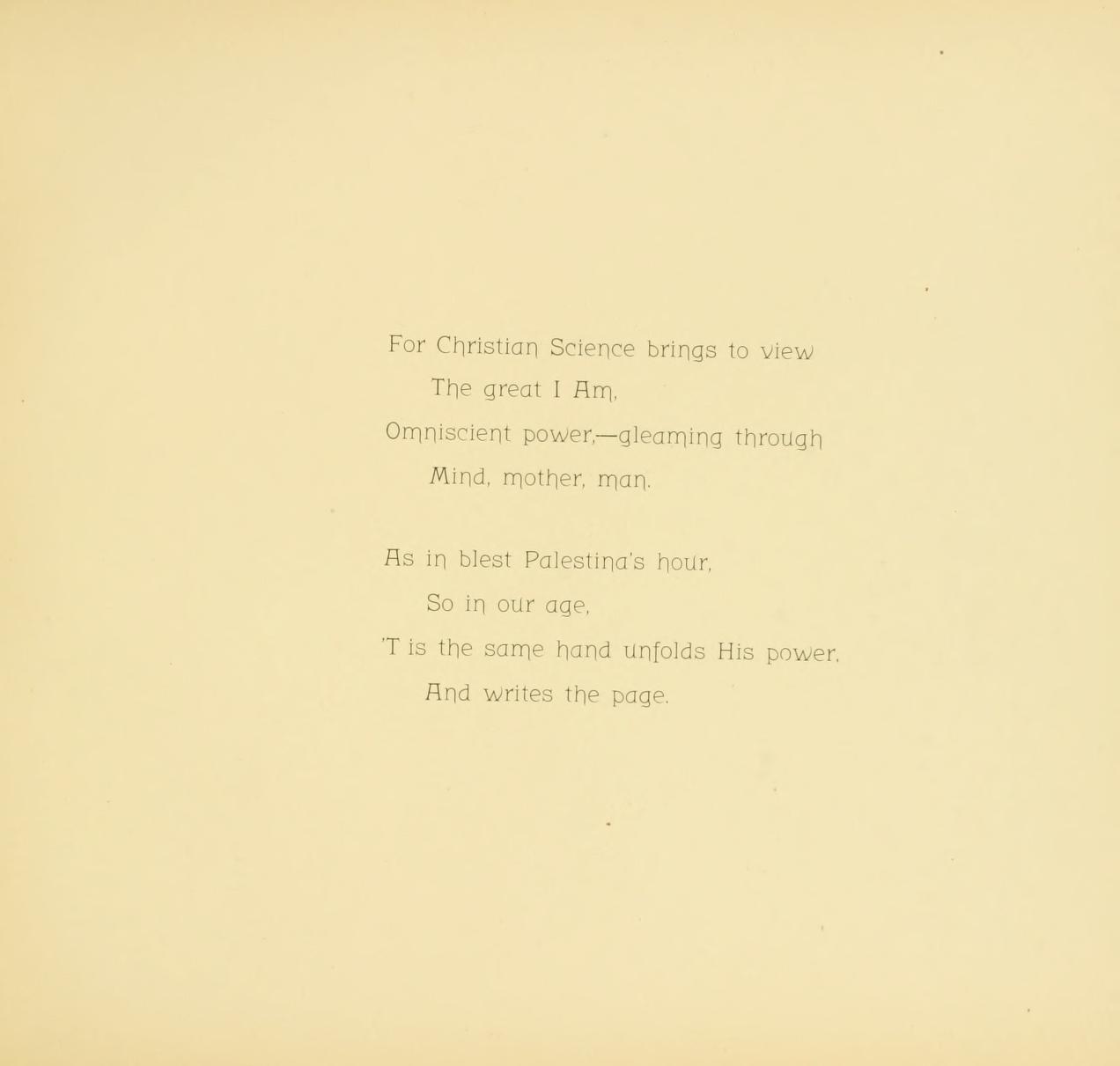


Sunday, May 28, 1893. – A beautiful day, outwardly and spiritually. A day of pleasant memories. I walked up to the park after working out the Sabbath lesson, about 11 A.M. The air is clear and fresh after the rain of last night, and is laden with the sweet breath of apple blossoms. I remember it is just six months since the day I came to Concord and went, that first day, up back of the park to look the country round and possibly set eyes upon Mrs. Eddy's place; and so I went today up to the same place beyond the park, into the by-path leading into the oak shrubbery, and here I saw the beauty of Spirit which the outward world at this time seemed adapted to express. I saw I had a high mission to fulfill. The walk up here before was about the first of December and the season then, even as the season now, typified the state of my mind, especially as related to Mrs. Eddy and Christian Science progress. Then I had never met her and doubted if I ever should, or if it would be desirable for me, but held her in great reverence and felt it would be sufficient for me if I should be so honored as to make pictures that she should find any pleasure in viewing, especially so much as should entitle them in her thought to a place upon the walls of any of her rooms.
Now I find myself after a brief six months a trusted one, engaged in a sacred work of making illustrations of a great and beautiful poem that she has lately written, the most important illustrations in their main features so well done and so forcible in their thought which the poem expresses, that Mrs. Eddy is moved to tears of joy at the great success and says, "God bless you" to me with great feeling. "You are doing a great work in this and still have a great work to do." The value of the pictures is in the spiritual thought they express; and the joy of this is in the new sense of God which preceding their execution has made it possible that they shall be thus successful, and this new sense has been due to Mrs. Eddy's purity and spirituality. Without that it would have been simply impossible for me to have made anything of any value whatever in this connection of illustrating this very spiritual poem. James Gilman
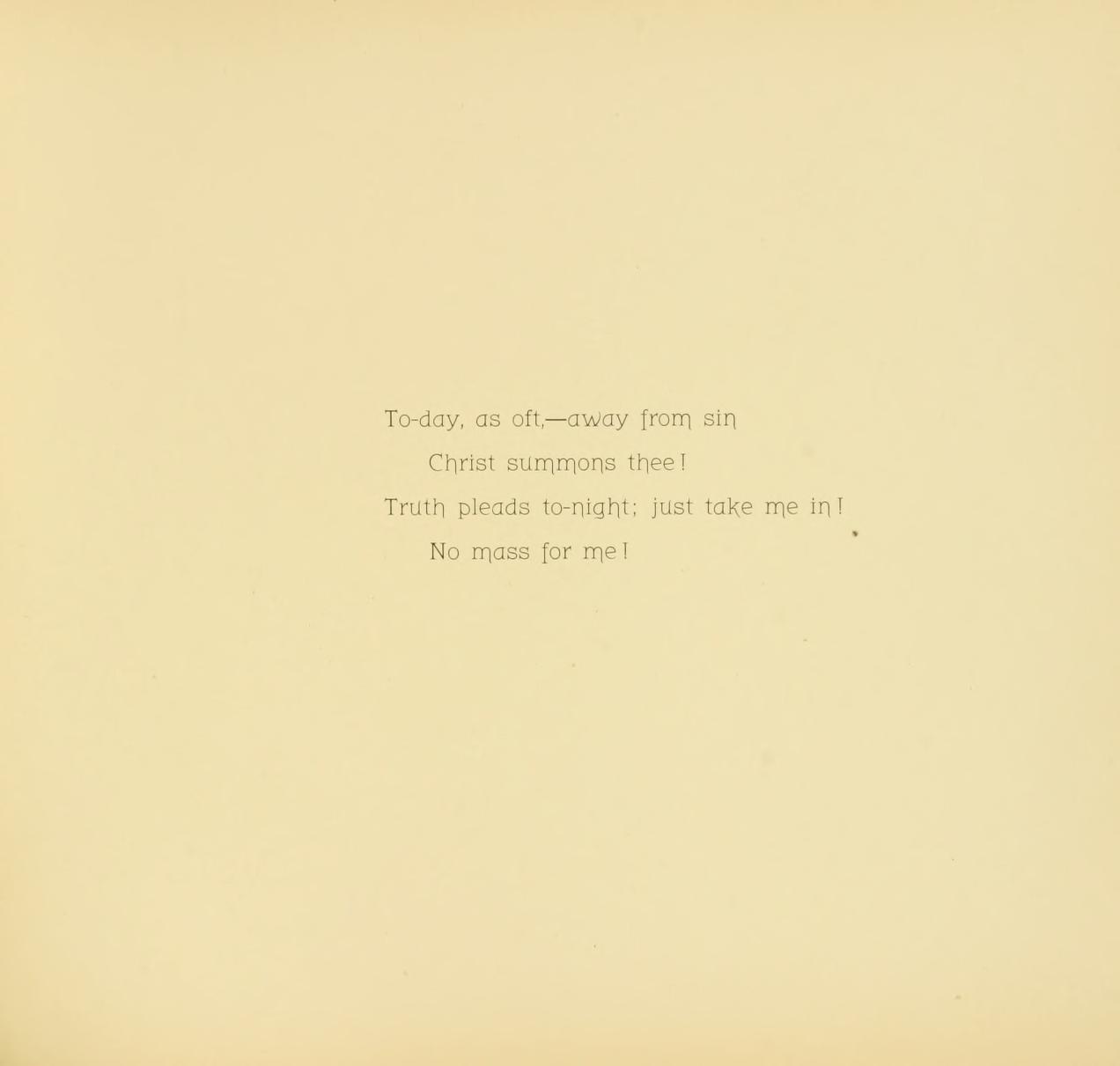
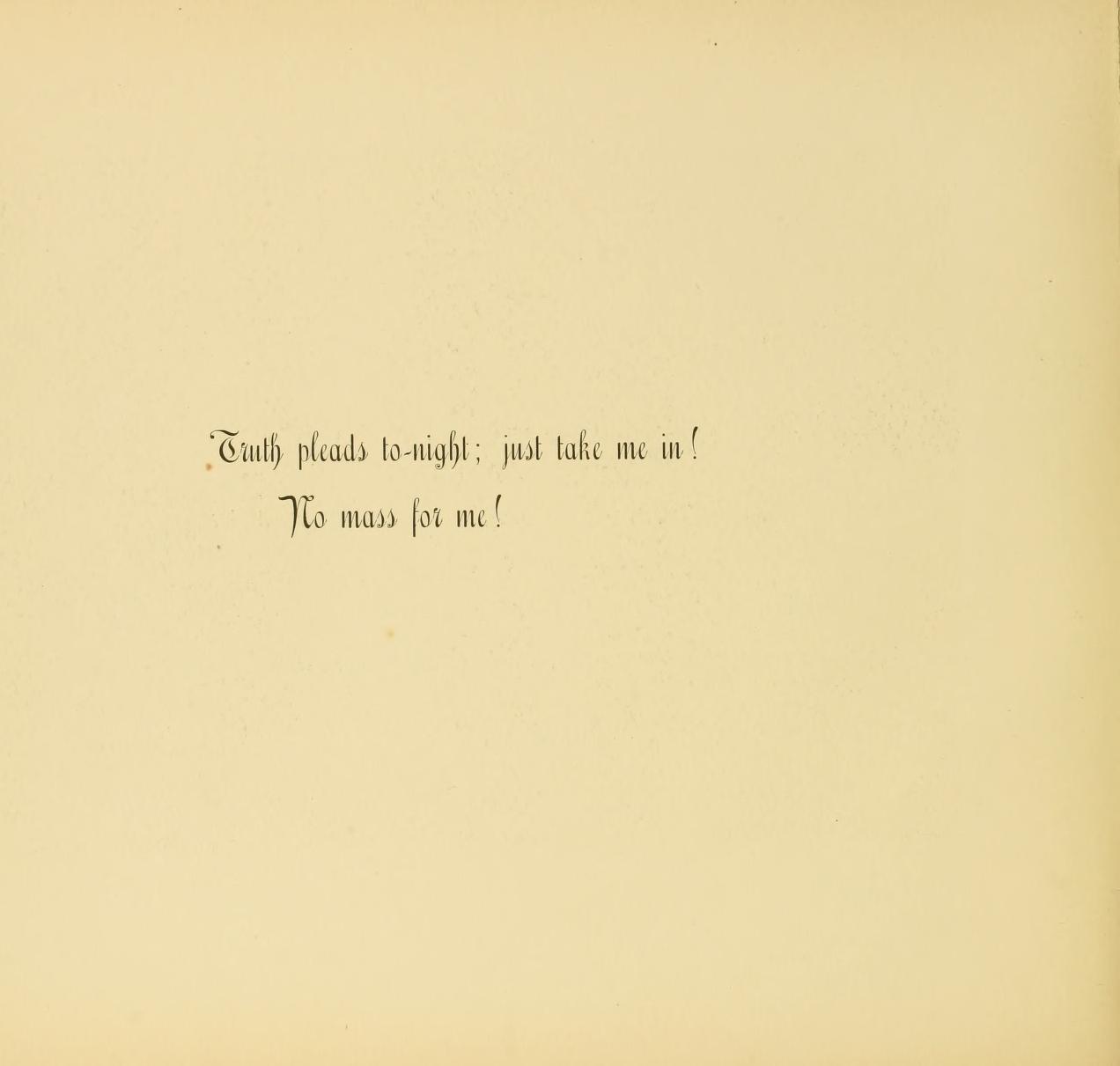

This conception of Mrs. Eddy's of one of the leading illustrations of the poem is naturally very inspiring to me, and this spiritually beautiful one to represent Mrs. Eddy's perfect Science thought of Christ began soon to unfold in my waiting thought and to engage my sacred attention day and night until in due time definite designs of the mansion representation of mortal mind with the pure messenger at the door in accord with the substance of Mrs. Eddy's spiritual thought expressed to me in her spiritual way of appreciation of all that is lovely and beautiful in Truth, began to take form in my sketches of the same.
One of these details related to the book in the hand of the messenger at the door with the word "Truth" upon it. A book was the first thought because Mrs. Eddy's Science thought was embodied in a great book. The attempt to make use of a book in this connection finally resulted in a humorous presentment of it to our thought, causing much laughter on the part of Mrs. Eddy and her artist because by something that was lightly said it appeared to suggest the call at the mansion of a "book agent," so that the book thought was given up, and a scroll was then thought of and substituted for it.
Yesterday I was there at 1:30 o'clock P.M. with the picture of the messenger of Truth at the door of the mortal mind mansion. She had brought down a box of pictures of herself to show me that I might gain a good idea of her as she used to be, or look. After I had looked at them, she found that two of them that she wanted particularly to show to me were not there, so she signaled "Laura" and when she came asked her to get them in her room and bring them. Just as she came, I took up the picture of the last scene in the poem to show to her. This picture is the one she has wanted should be the most impressive, and I was feeling I had succeeded so well that I felt confident she would like it. The conception and execution of it had come to me this past week since Tuesday evening, when I was striving harder than ever before to realize my true normal manhood in God, as Christian Science teaches, and to keep from falling into the drowsy mesmeric sleep as related to spiritual consciousness which Mrs. Eddy's thought particularly of last Tuesday evening showed to me I was continually doing.
As soon as Mrs. Eddy's eyes rested upon the picture, she was very still for a moment and then she said, "Laura, look here! look at that picture!" I began to fear that it looked dreadful to her on account of the exposed shoulder and breast, especially when Laura began to say, "Oh! Why, Mother, Mother," but adding, "Isn't that beautiful! beautiful!" reassured me, and Mrs. Eddy echoed her words, and they both were in that joyousness that finds expression in tears and Mrs. Eddy was saying, "It is the perfect representation of the ideal I had in thought, but could not exactly describe." Afterwards when Laura still having the pictures in her hand that she had brought down, holding them toward Mrs. Eddy, said, "Here are the pictures you wanted," Mrs. Eddy said, "We don't want them now. He has got the picture perfect."
After this I went up to her room when she was ready – her sitting-room chamber, where she writes and attends to her daily work – and sketched her foot for this same picture, a place being left in the picture for that to be done according to a previous arrangement. Here when I came to go she considerately remembered to come to the door with me and give me her hand in good-bye and "God bless you" before referred to. James Gilman
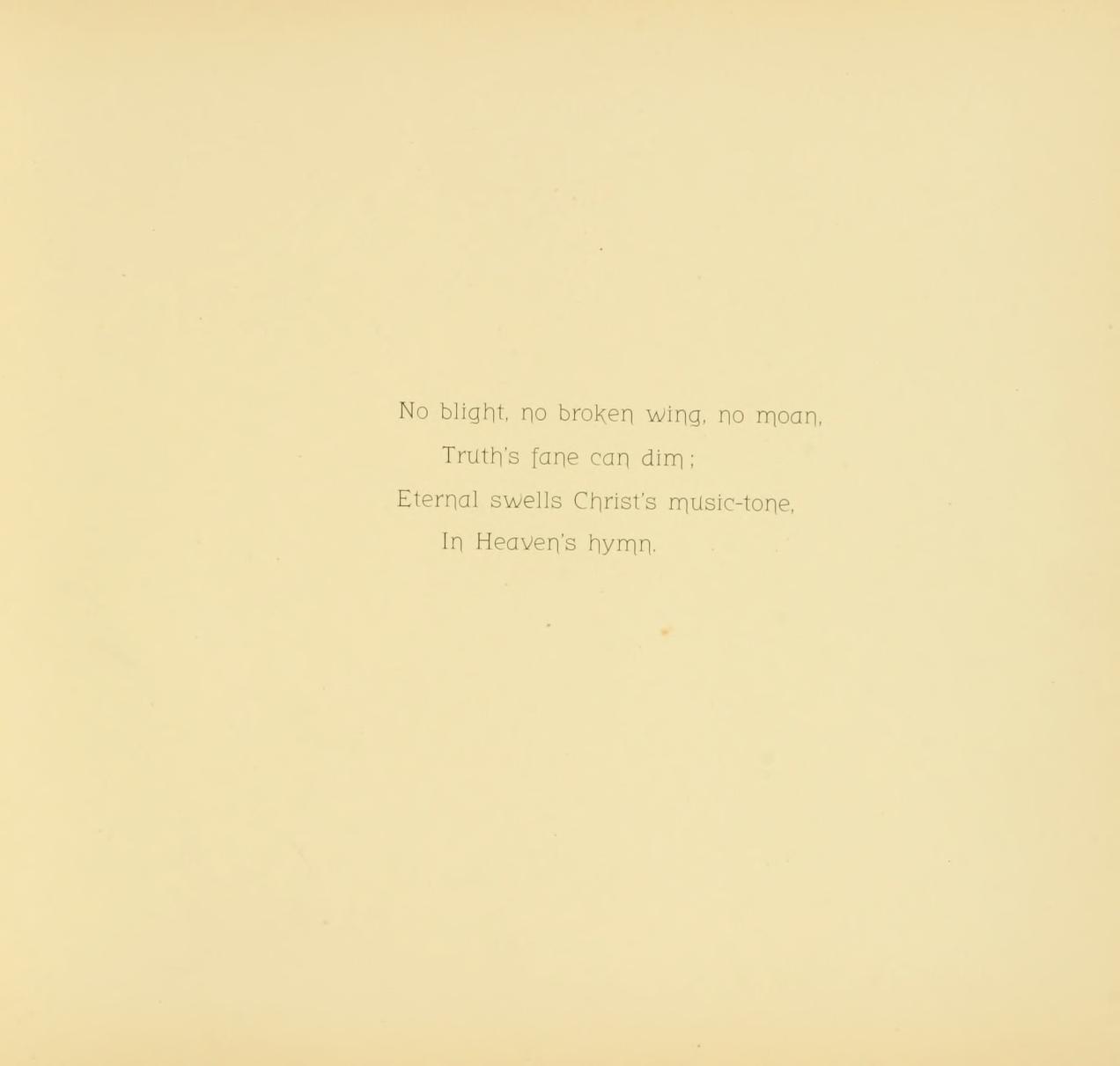


"Mr. Gilman, Christian Scientist April 30, 1897
My dear friend:
"Do you know what you have done for yourself, for mankind, for our Cause? No, you do not, perhaps, but I will tell you. You have illustrated and interpreted my life on the plate that you sent me."
Mary Baker Eddy

I heard her talking in the dining-room with Mrs. Sargent concerning something that had just arrived. Mrs. Sargent exclaimed, "O, isn't that just lovely!" After a little Mrs. Eddy opened the library door a little cautiously, asking me if I had finished reading the sketch. I replied that I had and she came in bringing a book, saying, "I have just received a copy of my illustrated poem," and taking a seat beside me, she was all animation to show it to me and enjoy with me this first appearance of the poem and all complete, which we had labored on so much during the past summer. She seemed to me like a very beautiful young lady as she sat necessarily near to me in order to look over with me and point out the different styles of type and other features connected with its make-up at the printer's and binder's, which were new to me of course. She made me look at the covers, both front and back, and then inside the covers at the lining, before proceeding to look inside the book, as if she would keep me waiting as long as possible to see if I would show any impatience to see the arrangement of the pictures with the poem, etc. It was at this period of showing me the get-up of the book that the leaf before the "Finis" that ends the printed matter of the poem, was brought to my view, revealing to me in the center of the leaf, alone, these words:
Mary Baker G. Eddy
and
James F. Gilman
Artists
This was unexpected to me, and far more than compensated the disappointment I had felt when Mrs. Eddy requested me, at the time of the first efforts to get good reproductions of the originals, not to have my name or initials on any of the illustrations as is common with artists to sign their pictures.

Tuesday, December 19th. – Go up to Mrs. Eddy's to lunch today at noon in response to a letter received yesterday inviting me with the promise that she had "a good laugh in store for me if nothing more." At once Mrs. Eddy appeared at the top of the stairway with a written letter in her hand before Mrs. Sargent completed the taking charge of my things.
She looked down the stairway to me with a welcome smile and greeting, immediately coming down, and after her usual greeting by handclasp, she at once began to talk about the letters she had received concerning the Christmas Book and the criticisms, mostly favorable, the unfavorable ones coming from New York. She then read me portions of a letter she had in hand from Miss Annie Dodge of Boston whom Mrs. Eddy said she valued greatly as an art critic because she had studied art in Europe a long time under the greatest advantages, having abundance of wealth. The letter was discriminatingly critical and highly commendatory of the pictures of illustrations, even comparing them in many respects favorably with the old masters of painting, especially the head and figure of Christ.
The New York critics had written that one objection to the Ascension picture was that the scene was located in Concord, New Hampshire (doubtless owing to the New Hampshire appearance of the trees). I acknowledged to her that I myself had recently thought of that, having had more time to consider it. "But," I said after a little, "I do not know as we need to go back to Jesus' day in Palestine to represent this thought." To this she quickly agreed, and having been called to lunch some minutes before, she arose and saying to me, "Lunch is ready," she extended her hand and took mine and led me like a child into the dining-room to the table. She resumed her talking about adverse criticism, new thoughts occurring to her which she expressed in much gleefulness, saying she should write directly to the Journal and have added her later thoughts to the article she already had prepared. It was late in the month, but she should ask Judge Hanna to delay the Journal, and she believed he would. The substance of the fresh thought that she wanted added was that Christian Science was a modern thought and was appropriately expressed in modern surroundings.
"There is too much looking backward two thousand years. They will find," she said, "that there is a Way here in Concord as well as in Palestine."
James Gilman
